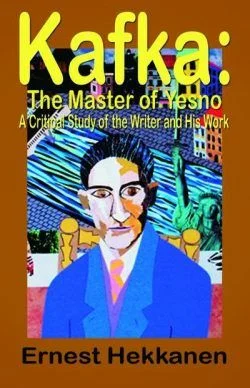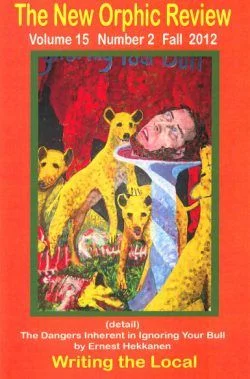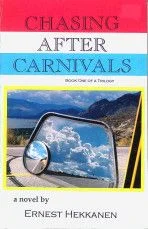#527 Canadian graffiti
Graffiti, Canadian Style
by Ernest Hekkanen
First published in The Ormsby Review, April 9, 2019
*
It was twenty years ago, in 1999, that Ernest Hekkanen wrote this diatribe about why Vancouver public art is so godawful, why Canada’s granting agencies can be foolish or corrupt, and why he rejected a contract from a respected “trade” publisher when asked to help finance his novel’s publication. Here, Hekkanen gets a few things off his chest about his long career as a successful writer and publisher in British Columbia.
The complete series of Ernest Hekkanen and Margrith Schraner’s New Orphic Review (1998-2017) is now available free of access on its own page at The Ormsby Review — Ed.
*

IN CANADA, the majority of writers and visual artists are little more than glorified purveyors of graffiti. We might as well be spray-painting our texts and images on buildings and underpasses, because, for the most part, what we produce is given hardly a glance of appreciation and certainly it is deemed about as important as graffiti by members of the larger society. We might desire greater appreciation, but a brief glance is about as much appreciation as we can expect; after all, this is a meat-and-potatoes sort of country, the values of which are encoded in the metaphor time is money, and let’s face it, we have barely crawled out of the bush here in Canada. The majority of us wouldn’t recognize what comprises good art and literature, even if it were wagged rather flamboyantly in front of our faces. This is a difficult situation for most writers and artists to endure, let alone survive, but it is our lot in this country, and in many regards we deserve it and even contribute to it, for we are in the habit of serving up what is expendable, what is disposable.

In a postmodern world where form and structure deconstruct and are then folded back into the greater flux of things, it is almost a given that we will be able to produce little more than disposable art and literature — or, if you will, graffiti. We artists and writers have been so affected by this postmodern dilemma, we have shrugged our shoulders in defeat or have willfully capitulated to it, declaring for all to hear: “Well, if rubbish is what they want, rubbish is what I will given them.” I guess we could blame the movement that elevates rubbish to the level of fine art on the Dadaists and on icons of modern culture, figures like Andy Warhol, Jackson Pollock, Allen Ginsberg and Ed Sanders, all of whom made it look as if anyone capable of producing a mark or uttering a sound could become an artist or writer; but that seems a trifle too easy to do, and anyway, we would be widely missing the mark, now, wouldn’t we?
In the current issue of The New Orphic Review, Hrothgar Malach attempts to understand why there is such a proliferation of terrible public art in Vancouver; however, I don’t think she goes far enough in her examination. She decries the abundance of pathetically rendered murals in this city, as well as the artistic standards that give rise to them, which is all well and good but which only scrapes the surface of what is going on. Our city and provincial fathers, whose taste in art and literature is about as well-developed as that of chickens, have deemed art, literature and theatre to be of some importance to our quality of life; however, the aesthetic yardstick they use to determine the quality of a work has but two marks: 1) the art must be disposable, and 2) it must be accessible to the hordes.

In this city, developers are allowed higher density levels as well as exemptions from certain planning rules if they include in their developments little artistic concessions; however, what qualifies as art is so pathetic, so sub-standard, our city and provincial bureaucrats might as well do away with the clause that allows for the proliferation of this sort of crap-art. You might have run across the kind of art I am talking about. I am sure you have walked down the street and have seen tiles inscribed with words set in the sidewalk: words like salmon, nature, coho and waterfall. Or, perhaps, you have seen lookalike impressions of leaves pressed into the concrete. Or maybe, you have seen the tiles signed by Commercial Drive residents and offered up for viewing as you walk across the bridge that spans the Cut. This lowest common denominator crapola fulfills the art mandate of the city. The wonderful thing about art of this sort is that you can take a jackhammer to it, break it up, use a front-end loader to hock it into a dump truck and haul it away before anyone notices — which is what should happen to most of this public art; it should be trashed. The foremost aesthetic criterion used to determine the acceptability of such public art is that it be disposable.

In our parks you might have come across another form of public art: little artificial foot-stones with pebbles pressed into the concrete, mimicking children’s art — if, indeed, it isn’t children’s art. The primary determining factor for acceptability of such public art is that it be level with the lawn so lawnmowers can be driven over it. Perhaps, too, you have taken in such events as Illuminaires, The Mad Hatter Tea Party or the All Saints Festival in the East End of the city. The organizers of such events (largely the Public Dreams Society and the Fools Society) actually think they are contributing to community culture; they actually think they are presenting something novel and indeed interesting — for kids of all ages, as the advertising goes; however, if you have ever been to any of these events (or happenings) you probably realize that they amount to little more than hundreds and sometimes thousands of people milling around a pond or strolling in costumes through a park, sometimes holding masks or lanterns aloft. Above all, these events must be accessible to one and all and have as little form as possible; indeed, many of the individuals who ‘organize’ and promote these events think that form is totalitarian in nature, because form, for them, is dictated by some perceived authority whom they distrust. Many of the organizers and promoters of these events actually despise authority (for the most part, authorities should be despised, for they are little more than puppets whose strings are being pulled by cronies in business or labor unions) and yet the organizers and promoters of these events and this type of expendable art have no problem going to those very same authorities and begging to be given little hand-outs in support of their highly questionable artistic endeavours.


It is all a lot of muck and malarkey! As soon as a writer or artist approaches the government for financial support to engage in his endeavours, he has already become a defeated figure — a buffoon, a squirming maggot who survives on the carcass of the state; he has already capitulated; he has already compromised his artistic and literary integrity. In The Rebel, Albert Camus begins by saying: What is a rebel? A man who says no, but whose refusal does not imply a renunciation. He is also a man who says yes, from the moment he makes his first gesture of rebellion. A slave who has taken orders all his life suddenly decides that he cannot obey some new command. What does he mean by saying “no”?
He means, for example, that “this has been going on too long,” “up to this point yes, beyond it no,” “you are going too far,” or, again, “there is a limit beyond which you shall not go.” In other words, his no affirms the existence of a borderline…. Rebellion cannot exist without the feeling that, somewhere and somehow, one is right…. [The rebel] demonstrates, with obstinacy, that there is something in him which “is worthwhile….”and which must be taken into consideration. In a certain way, he confronts an order of things which oppresses him with the insistence on a kind of right not to be oppressed beyond the limit that he can tolerate.

A rebel, in other words, believes that there is something of value in himself that must not be trampled upon or treated in some fashion that is reprehensible. My feeling is that writers and artists operate more or less out of the same modus operandi; they insist that there is something of value in them that the society as a whole should take notice of — that should be appreciated, that should not be demeaned; and yet many of our artists and writers regularly demean themselves by begging for handouts that granting bodies only reluctantly give. Which brings me to the Canada Council and such organizations. Back in the late 1960s, the government decided to encourage artistic and literary endeavours by offering a plethora of grants. In no time at all we saw an amazing number of galleries and publishing houses spring up across the country; many of these were artist-run galleries and writer-run publishing houses, the existence of which was subsidized by the governments of the day. Bureaucrats, urged on by artists and writers, perceived that it was good for Canadians to have their images reflected back to them, because, apparently, Canadians would not be able to otherwise identify themselves as Canadians. Artists and writers coagulated like globs of cold grease around these artist-run galleries and writer-run publishing houses, many of which survive to this day and continue to suck down grant money as if it were twenty-year-old Irish whiskey.

Many of the artists and writers who got in on the ground floor of this scheme are now prominent members of the artistic and literary community; however, the majority of us continue to struggle in near-anonymity, probably with good reason. Canadians didn’t exactly beat a path to galleries and bookstores in order to purchase the offerings spewed up by the artists and writers who benefited from the above federally-and-provincially funded schemes. Nor do they today. Very few Canadians buy Canadian art or literature; indeed, such art and literature is perceived to be inferior, whether rightly or wrongly. Most Canadians don’t go out of their way to invest in such stuff of their own accord and there is no reason why they should. Consequently, only very few writers and artists rise like scum to the surface of the Canadian cultural pond; the rest remain bottom feeders, without distinction, without acknowledgment, forever raging about their anonymity.
In the 1970s, Canadians became almost neurotically involved with the question of their identity; but it was all a sham, it was all a put-up job, promoted by the government and the media, apparently for nationalistic reasons. However, back then, if you got off the main highways of Canadian culture and ventured forth into the hinterlands, the folks there didn’t have any identity problems; they knew who they were and what they were all about. For the most part, they were hardworking schmoes who were more than content to be compost for the next generation; they were people who didn’t deign to sit and gaze at their navels or mess with their heads — indeed, for the most part, they were unimaginative dullards. Unimaginative dullards, unfortunately, don’t buy art and don’t buy literature; they can do very well without it, thank you. Give them a highway; they can understand that, they can wrap their imaginations around that. You see, it became a force-feeding sort of situation; higher-ups were trying to cram art and literature down the gullet of the masses, and that is still pretty much the case today.

Canadian art and literature don’t have a very wide base of financial support among the great, unwashed citizenry, and so art and literature has to be propped up on every side by government-funded crutches. The result is that artists and writers have gathered around the federal and provincial funding bodies and a whole government-funded industry has come into existence. Those artists and writers who got to the pig-pile first became government agents who in turn dispersed funds to friends and acquaintances and this sort of graft has been going on now for decades. Juries of like-thinking peers determine which projects will receive funding support and which projects are to be deigned unworthy. If you really want a grant, make sure you have the proper references or know someone on the adjudicating body. Places like the Banff School of Fine Arts are little more than clearing houses for those who wish to get grants; fledglings attend the Banff School in order to make contacts — to get references. Indeed, today, there is often a lot more artistry and literary skill displayed in the filling out of application forms than there is in final projects. The art of filling out application forms and knowing the right people who can help you along the way is often more important than the talent you display.

Am I simply being cynical? No, I don’t think I so, because, you see, I was once the recipient of a Canada Council “B” Grant. Annually I filled out the application form and dutifully sent it off to the Canada Council — without ever receiving a grant. One year, I decided to forego this fruitless activity, but magically an application form appeared in the mail. On perusing it, I discovered that certain passages had been highlighted by a yellow marking pen. The highlighted passages were of little significance; what was of significance was the fact that someone had gone to the effort of highlighting the passages and sending me the application form. It indicated that someone on the adjudicating body was familiar with my work. To test the situation, I filled out the form for a project that had been rejected the previous year for not having sufficient merit and, lo and behold, I received a “B” Grant. Another such instance of government largesse going to the correct applicants is typified by a certain high-profile artistic director in the Vancouver theatre scene. He sits on the board of the B.C. Arts Council, but “steps” out of the room when other board members vote on whether or not to give him over $200,000 of grant money — which, of course, he is never denied; indeed, the amount he receives usually goes up every year. None of his cohorts on the council would have the temerity to deny him this funding, for they in turn might be denied theirs.
Does this sort of thing smack of incestuousness or what? I believe it does.

Very few people in Canada read my books, not because my books are badly written, but rather because they aren’t promoted by the CBC, because they aren’t highly touted by the press, because they aren’t part of the academic curriculum and, let’s face it, because they are a little too weird for the taste of most Canadians. Which is all well and good. Except for the lone “B” Grant I received over a decade ago, I and my work are not being funded out of the public trough, unlike the majority of literature and art being produced in this country. Most novels and collections of short stories are produced in runs of a thousand to fifteen-hundred books. The production costs of such books are more or less written off by block granting funds. Once the publisher has sold as many copies of a book as he possibly can to libraries, he tends to lose interest in selling the remainder of the run, because Canadians simply don’t buy very many Canadian books. Half, if not more than half, of every run ends up sitting in a warehouse, until the books are finally shredded or end up in a landfill site or are sold to the author at a reduced price. On being sold to the author, the books usually end up occupying a dark corner in a basement — in the form of terribly depressed stock. If authors refuse to buy the remainder of their books, they usually find it a lot more difficult to get subsequent books published by that house.

You see, the difficulty is that too few Canadians buy too few Canadian titles to justify an entire industry and that industry wouldn’t exist if not for government largesse. Government largesse has created a dozen or so publishing fiefdoms across the country, and the Lords and Knights who rule these fiefdoms cry foul very loudly and persistently when their kingdoms are put in jeopardy through lack of funding. They play the cultural trump card over and over again, insisting that we need Canadian venues for Canadian voices. However, the vast majority of Canadians never hear the voices that are apparently crying to be heard in the wilderness that is Canada. The situation is enough to give new meaning to the old conundrum, if a tree falls in the forest when no one is around, does it make a sound? My contention is that if all the little voices comprising Canadian literature fell silent today, Canadians wouldn’t be any better or worse off for it; Canadians wouldn’t care, they wouldn’t give a shit. They prefer highways to literature and art, so why not give them more highways. Our writers and artists can spray-paint their texts and images on the highways. I am sure that way many more Canadians would likely view what has been wrought by the art-lit set.

I’m the sort of artist and writer who is in favour of non-funded, spontaneously-arising graffiti; indeed, some of that graffiti can be quite artistic. It often expresses a lot of anger, energy, dissatisfaction and disaffection and that is why the majority of us find it difficult to entertain. It is the anarchistic expression of the rebel, the angry young woman or man who isn’t on the program and isn’t likely to be, not in the near future, certainly. These graffiti artists produce texts and images in defiance of the metaphors time is money and property is worthy of respect. They exhibit a lot more stealth, cunning, courage, and entrepreneurship than most of the “legitimate” artists and writers working in Canada today. Self-publishers such as I have more in common with graffiti artists than we do with government-sanctioned artists and writers. We ask nothing from the government, and yet we produce work regardless, in the tradition of Camus’ treasonous rebel. Furthermore, we aren’t obliged to write or produce images in the proper Canadian style and we don’t have to suck up to the Lords and Knights who rule the cultural fiefdoms. In addition to that, we don’t have to pretend that we are producing “significant” literature and art in the oh-so sanctified Canadian tradition, which is staid, stodgy and proper to the point of being anally retentive.

Let’s take a brief look at our hallowed cultural fiefdoms. How do they operate and are they really free of the taint of self-publishing or self-financed art. My novel Chasing After Carnivals was supposed to be published by Stoddart back in 1985. On the eve of the publishing date, my editor informed me that Stoddart had run into some financial difficulties and would not be able to bring out my novel by the specified date, even though it had reached the bound galley proof stage and had been reviewed. Six weeks later, I was told the same thing; and three months after that, I received a similar reply. “What will it take to bring out my novel?” I naively asked my editor. “Well, Ernest, if you’ve got a few thousand dollars you can put into this venture, I’m sure it would come out in no time at all.” In other words, I was on the wrong end of a shake down. Rather than submitting to such terms, I asked to have my contract nullified.
This practice is still going on, and most of the time it is used on first-time authors. I’m not against authors defraying the costs of book production; however, the practice of touching up authors for money in this manner is not supposed to be going on at “legitimate” houses which receive funds from the government for producing books. It amounts to little more than blackmail.

Many Canadian writers and publishers decried the takeover of Random House and Doubleday Dell by the huge conglomerate Bertelsmann. I would submit that the reason most writers and publishers feared this takeover has more to do with them fearing that their government- subsidized fiefdoms might not be able to operate as usual. Myself, I am all for the takeover by Bertelsmann. I am all for busting up these little self-aggrandizing publishing fiefdoms, which are so thick from inbreeding they have put into jeopardy their élan vital. In fact, they are so wan they deserve to expire.
By the way, most authors in this country receive around a dollar per book in royalties. Five to six hundred books are normally sold (usually to libraries), which amounts to a very small royalty check, indeed — that is, if the author is able to get the publisher to write him or her a check. No writer can survive on such chicken feed. He or she might as well be producing graffiti; it would be just about as financially rewarding.
In the current issue of The New Orphic Review, the theme is One Person’s Graffiti / Another Person’s Art. Many of the pieces stretch the idea of what a poem or a story is; indeed, some of them might irritate you, our gentle, cherished reader. But not to worry. The pieces herein have not been published at public expense. They have been produced out of necessity and have been moved by spiritus mundi to a greater or lesser degree. They have been created in defiance of the prevailing rules and are marked by a disregard for what is so doggedly Canadian. Art and literature, if it is to survive in this country, must never lose the underpinnings of self-sufficiency, otherwise art and literature will become weak and devitalized, hobbies practiced by sycophants. The works herein represent a kind of graffiti in that they have been executed in defiance of the prevailing cultural mandate and have not come to your attention because of a government agency that has benignly distributed some alms.

*

Ernest Hekkanen writes: When Margrith Schraner and I started our literary journal, The New Orphic Review (NOR), back in 1998, we had just turned 51. I had written three novels. We were living in Vancouver, at Napier and Victoria Drive, and we were full of irrepressible — dare I say youthful — optimism. Literature, for me, had become a matter of defying the odds. To create a product for which there would be an extremely limited market, if any at all, seemed to me an act of defiance worth pouring some hard-earned cash into. In the spring of 2016, NOR suffered a cryptolocker cyber-attack. I chose not to be held to ransom, despite the fact that it meant losing all of my active files. In the spring of 2018, after NOR ceased publication, Alan Twigg urged me to consider archiving NOR before it was lost to time. Margrith and I were planning a trip to Vancouver anyway, where she intended to take a course, and I — well, I intended to roam the streets, refreshing memories of when I had first come to Vancouver in 1969, as a 22-year old American wanted by the F.B.I. for my anti-war activities. And so, it came to pass. On March 9th Alan, Margrith, and I met at the Prado coffee shop on Commercial Drive with Richard Mackie, editor of the online Ormsby Review, who would be working with us on the project. It was enough to persuade me to join the enterprise.
*
The Ormsby Review. More Books. More Reviews. More Often.
Publisher and Editor: Richard Mackie
The Ormsby Review is a journal service for in-depth coverage of B.C. books and authors. The Advisory Board consists of Jean Barman, Robin Fisher, Cole Harris, Wade Davis, Hugh Johnston, Patricia Roy, David Stouck, and Graeme Wynn. Scholarly Patron: SFU Graduate Liberal Studies. Honorary Patron: Yosef Wosk. Provincial Government Patron since September 2018: Creative BC
“Only connect.” – E.M. Forster































